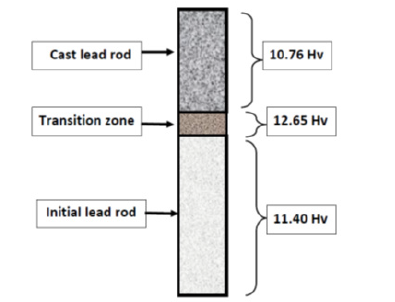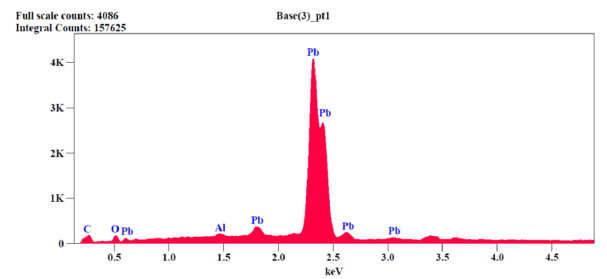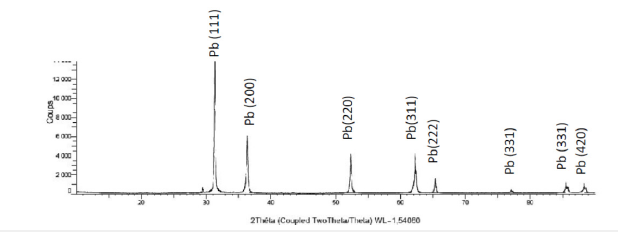- Submissions

Full Text
Research & Development in Material Science
Downward Vertical Continuous Casting of Industrial Lead
Zakaria Boumerzoug*, Nahala Soundsous Boutaba and Khawla Helis
Mechanical Engineering Department, University of Biskra, Algeria
*Corresponding author:Zakaria Boumerzoug, Mechanical Engineering Department, University of Biskra, Algeria
Submission: July 12, 2023;Published: July 19, 2023

ISSN: 2576-8840 Volume 19 Issue 2
Abstract
The purpose of this study is to present the production of lead rod by the use of vertical downward continuous casting. The lead rod was characterized by optical microscope, by scanning electron microscope equipped with EDS, by X-ray diffraction and by Vickers microhardness measurements. The results obtained showed that the lead metal produced by this process has properties similar to the rod used for its production.
Keywords:Lead rod; Continuous casting; Microstructure; Hardness
Abbreviations:HV: Hardness Vickers; EDS: Energy Dispersive Spectroscopy
Introduction
Continuous casting is a process for casting molten metal. Continuous metal casting is an operation in which molten metal is introduced into a mold which has the ability to rapidly cool the metal to the point of solidification. As the metal cools and solidifies, usually due to water cooling systems, which surround the mold, the finished cast metal protrudes from the end of the mold [1].
This process is widely used in the production of copper, steel, aluminum, and other metals and alloys. This process has several advantages, such as high productivity, improved quality and consistency, energy efficiency and reduced labor costs [2]. The continuous casting can be done horizontally or vertically. Both processes use the same principle, but the layout of the equipment is different. In the horizontal process, the various parts of the equipment are extended on a single level and horizontally [3]. However, in the vertical method, the various parts of the equipment are arranged vertically. For the vertical continuous casting process, there are casting machines which can cast products vertically up or down. Unlike vertical downward continuous casting, the continuous vertical downward casting process uses gravity to feed the metal into the mold [4]. This process which is used in this study is widely used in industry and especially for the manufacture of steel bars and other metal alloys.
The production by continuous casting of lead and its alloys requires more investigation because according to the literature, there are few works on this research topic despite its wide use in certain fields of industry such as the manufacture of batteries and welding rods. For example, PbSb alloys are widely used in many industrial applications, such as cable sheaths, anti-friction bearings, welds and battery grids [5]. Pb-Sn-Ca alloys are most widely used for making grids of valve-regulated lead acid (VRLA) batteries [6]. Verwijs et al. [7] investigated the influence of mold length and mold heat transfer on horizontal continuous casting of Pb rods. They found that for lead cast in molds longer than 12mm, the minimum observed casting speed was constant at 4.0mm/s and they concluded that casting speed increase was with the increase of mold length. Ehsaan-Reza et al. [5] studied the effects of the addition of antimony on the structure of pure continuously cast lead and lead alloy rods. They found that the addition of antimony improve the tensile strength of the continuous cast lead alloy. Grids made by punching or continuous casting from a Pb-SnCa alloy with a barium additive provide the improved mechanical properties and the increased corrosion resistance.
The objective of this study is to present the casting of industrial lead in a downward vertical continuous casting machine.
Experimental Procedure
Figure 1 shows a general view of the downward vertical continuous casting machine manufactured in the laboratory. This machine consists of an electric melting furnace where the lead is melted at a temperature set at 500 °C to ensure its fusion then the liquid metal flows through the graphite crystallizer surrounded by a copper tube in which circulates a water to make it solidify. Note that a lead rod is placed vertically which crosses the crystallizer to the base of the furnace which is then stretched at a speed of 1mm/ min. Thus, the liquid solidifies on contact with the upper end of this lead rod. The pulling operation continues until the total liquid comes out as a solid rod. The latter will undergo secondary cooling by a jet of water.
Figure 1:The downward vertical continuous casting machine.

The lead rod obtained after casting is then cut transversely to analyze it by optical microscopy, by scanning electron microscopy, by Vickers microhardness measurements and by X-ray diffraction. It is noted that the sample taken is polished by the various abrasive papers and then it will undergo a finishing polishing by applying a diamond pad of 1μm. The sample is then attacked with a solution of 50ml distilled water + 8ml nitric acid + 5ml acetic acid with a chemical etching time of 10s.
The measurement of the hardness was carried out using a Vickers hardness device of the HVS-1000 Z type under a load of 50g. The scanning electron microscope used is of the Prisma E type and it is equipped with chemical analysis (EDS: Energy Dispersive Spectroscopy). The X-ray diffractometer is of the Empyrean type, where the analyzes were carried out under a voltage of 40KV and an intensity of 20mA using a copper anticathode (λ=1.54Å).
Results and Discussion
In this part the obtained cast lead and its characterisation were presented. Figure 2 shows the macrographic view of the cast rod made of lead. As it is shown, the solidified part is perfectly joined to the rod initially placed to facilitate the solidification of the liquid lead in rod shape. It is known that the early solidification in continuous casting occurs as a partial freezing of the meniscus curvature from the point of contact with the mold liquid [8].
Figure 2:General view of the Pb rod produced by continuous casting.

To confirm the quality of the casting process, a piece was cut just in the connection area between the solidified liquid and the rod used to facilitate the process of solidification of liquid lead. The hardness measurement has shown a slight difference between the different parts of the sample (Figure 3).
Figure 3:Hardness measurements along the cast lead.

To analyze the chemical composition of the lead obtained after the casting, it was analyzed by EDS and the EDS chemical analysis spectrum of the lead is presented in Figure 4. It is noted that the existence of the main peaks of Pb as major element and other additional elements as C, O, and Al. The presence of these elements is explained by the fact that the cast metal is an industrial lead.
Figure 4:EDS chemical analysis spectrum of the lead.

X-ray diffraction analysis was used to verify the existence of new phases or compounds were formed in the cast lead. Figure 5 shows the X-ray diffractogram of lead after continuous casting. It can be seen that the existence of Pb peaks and no additional phases are either oxides or undesirable phases.
Figure 5:X-ray diffractogram of lead after continuous casting.

Figure 6 shows the cast lead rod microstructure which does not reveal a specific phase.
Figure 6:Microstructure of the cast lead rod.

Conclusion
The objective of this investigation is to manufacture a lead rod by continuous vertical downward casting in a machine designed for this purpose. The continuous casting of the industrial lead was successful and the analyzes showed the good quality of the material obtained.
References
- Vijayaram TR (2014) Metallurgy of continuous casting technology. International Journal of Manufacturing & Industrial Engineering 1(1): 17-36.
- Nian Y, Zhang L, Zhang C, Ali N, Chu J, et al. (2022) Application status and development trend of continuous casting reduction technology: A review. Processes 10(12): 2669.
- Technical Report (2023) Continuous casting process explained, types of continuous casting.
- Kromanis A, Ozolins J, Andrejevs S, Gerins E (2016) Influence of casting velocity on mechanical properties and macro- structure of tin bronzes. Key Engineering Materials 674: 81-87.
- Ehsaan-Reza B, Yongchang F, Mervyn C, Brian F, Amin A (2016) Conference Paper, Metal 2016, May 25th - 27th 2016, Brno, Czech Republic.
- Gullian E, Albert L, Caillerie JL (2003) New lead alloys for high-performance lead-acid batteries. Journal of Power Sources 116(1-2): 185-192.
- Verwijs JP, Weckman DC (1988) Influence of mold length and mold heat transfer on horizontal continuous casting of nonferrous alloy rods. Metall Trans B 19: 201-212.
- Mazumdar S, Ray SK, Sadhana (2001) 26(1 & 2): 179-198.
© 2023 Zakaria Boumerzoug. This is an open access article distributed under the terms of the Creative Commons Attribution License , which permits unrestricted use, distribution, and build upon your work non-commercially.
 a Creative Commons Attribution 4.0 International License. Based on a work at www.crimsonpublishers.com.
Best viewed in
a Creative Commons Attribution 4.0 International License. Based on a work at www.crimsonpublishers.com.
Best viewed in 







.jpg)






























 Editorial Board Registrations
Editorial Board Registrations Submit your Article
Submit your Article Refer a Friend
Refer a Friend Advertise With Us
Advertise With Us
.jpg)






.jpg)














.bmp)
.jpg)
.png)
.jpg)










.jpg)






.png)

.png)



.png)






